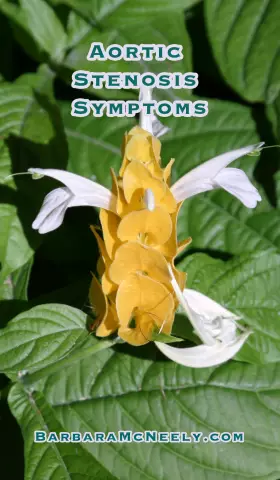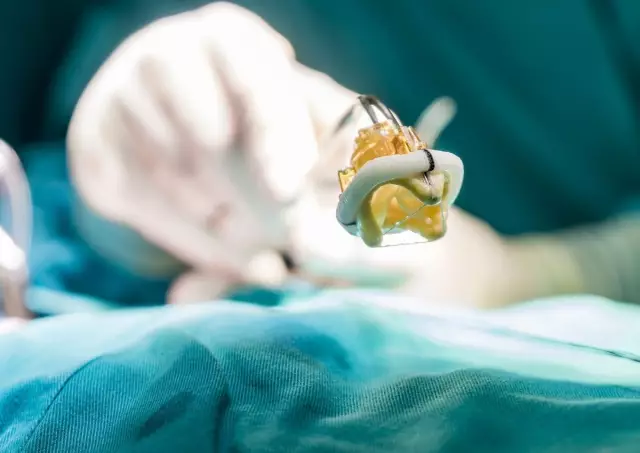- Author Rachel Wainwright [email protected].
- Public 2023-12-15 07:39.
- Last modified 2025-11-02 20:14.
Aortic aneurysm
The content of the article:
- Causes and risk factors
- Forms of the disease
- Symptoms
- Diagnostics
- Treatment
- Possible complications and consequences
- Forecast
- Prevention
Aortic aneurysm is an expansion of a limited area of the aortic wall, resembling a spindle in shape or a sac-like formation, or a diffuse increase in its lumen by more than 2 times compared to an unchanged area (or aortic diameter normal for a given sex and age).

Abdominal aortic aneurysm
The aorta is the main unpaired arterial vessel of the body; blood enriched with oxygen and nutrients in the left ventricle of the heart is transported through the aorta to all organs and tissues. The aorta has a complex structure: with distance from the center to the periphery, its branches dichotomously divide (bifurcate) into smaller and smaller arteries.
Due to the close proximity to the heart in the lumen of the indicated vessel, high blood pressure (BP) is normally noted - from 130-140 mm Hg. Art. at the time of contraction of the heart (systole) to 80-90 mm Hg. Art. during relaxation (diastole). The special structure of its walls, consisting of 3 main layers, allows maintaining the integrity of the aorta under conditions of such a high load:
- inner endothelial lining;
- the middle massive layer, filled with smooth muscle cells;
- outer collagen scaffold.
Under the influence of pathological factors, the aortic wall undergoes structural changes, after which it begins to stretch under the influence of the blood current. As the aneurysm grows, the normal structure of the aortic wall is lost, and it turns into a bag of connective tissue, sometimes filled with thrombotic masses.
According to the available data, the disease develops in 1.4-8.2% of patients aged 50 to 79 years (men get sick more often), which corresponds to 3 cases per 100,000 women and 117 cases per 100,000 men. In the Russian Federation, over the past 30 years, there has been an almost 9-fold increase in the incidence of aortic aneurysm.
Causes and risk factors
The main causes of aneurysm are diseases and conditions that reduce the strength and elasticity of the vascular wall:
- atherosclerosis of the aortic wall (according to various sources, from 70 to 90%);
- inflammation of the aorta (aortitis) of a syphilitic, giant cell, mycotic nature;
- traumatic injury;
- congenital systemic diseases of the connective tissue (for example, Marfan or Ehlers-Danlos syndrome);
- autoimmune diseases (nonspecific aortoarteritis);
- iatrogenic causes due to therapeutic manipulations (reconstructive surgery on the aorta and its branches, cardiac catheterization, aortography).

Atherosclerosis of the aortic wall - the main cause of aortic aneurysm
Risk factors for atherosclerosis and aneurysm formation:
- male gender (the incidence of aneurysms in men is 2-14 times higher than in women);
- smoking (during screening diagnostics of 455 people aged 50 to 89 years in the department of vascular surgery of the Moscow Regional Research Clinical Institute, it was revealed that 100% of patients with aneurysms of the abdominal aorta had a smoking experience of more than 25 years, and as a result of the Whitehall study it was proved that life-threatening complications of aneurysms in smokers occur 4 times more often than in nonsmokers);
- age over 55;
- burdened family history;
- prolonged arterial hypertension (blood pressure above 140/90 mm Hg);
- hypodynamia;
- overweight;
- increased blood cholesterol levels.
Forms of the disease
Depending on the pathomorphology, aneurysms are distinguished:
- limited;
- diffuse.
By localization of the pathological process, they isolate:
- aneurysms of the thoracic aorta (sinus, ascending part, arch, descending part, combined);
- aneurysms of the abdominal region (suprarenal, subrenal without affecting the aortic bifurcation, subrenal with affecting the aortic bifurcation, total);
- abdominal aneurysms.
According to the etiological factor, aneurysms are divided as follows:
- acquired (non-inflammatory, inflammatory);
- congenital.

Aortic aneurysm dissection
They also talk about a dissecting aneurysm, which forms as a result of rupture of the inner membrane, followed by its separation and the formation of a second false channel for blood flow. Depending on the location and length of the stratification, there are 3 types of pathology:
- The dissection begins in the ascending part of the aorta, moves along the arc (50%).
- Dissection occurs only in the ascending aorta (35%).
- The dissection begins in the descending part of the aorta, moves down (more often) or up (less often) along the arch (15%).
Depending on the age of the process, a dissecting aneurysm can be:
- acute (1-2 days after the appearance of the endothelial defect);
- subacute (2-4 weeks);
- chronic (4-8 weeks or more, up to several years).
Symptoms
The clinical picture of an aneurysm is formed by symptoms provoked by compression of neighboring organs, therefore, depends on the localization of the pathological formation.
Signs of aneurysm of the arch, ascending and descending parts of the aorta:
- persistent pain behind the sternum radiating to the back;
- shortness of breath with shortness of breath, noisy wheezing;
- bradycardia (with compression of the vagus nerve);
- difficulty swallowing;
- possible non-intensive recurrent pulmonary bleeding;
- weakening or complete cessation of the pulse (with compression of the subclavian artery);
- hoarseness of the voice (with compression of the recurrent nerve);
- positive symptom of Oliver - Cardarelli;
- narrowing of the palpebral fissure (when sympathetic cervical nodes are compressed);
- pressing pains in the stomach, sometimes accompanied by belching, heartburn, vomiting.

Persistent pain behind the sternum indicates an aneurysm of the thoracic aorta
Symptoms of an abdominal aortic aneurysm:
- persistent intense pain in the lumbar and epigastric regions;
- acute urinary retention;
- symptomatic increase in blood pressure;
- digestive disorders (nausea, vomiting, weight loss);
- possible movement disorders of the lower extremities;
- pulsating dense formation at the level of the navel or slightly below and to the left.
A dissecting aneurysm is manifested by the following sudden onset symptoms:
- sharp unbearable pains behind the sternum, in the back or epigastric region, which cannot be stopped by taking analgesics (the pain can subside and intensify, which indicates the progression of dissection, it can be wavy in nature, gradually migrating along the back, along the spine);
- increased heart rate;
- general weakness.
An aneurysm can be asymptomatic and diagnosed only at the stage of dissection or rupture.
Diagnostics
The main methods in the diagnosis of aortic aneurysm are methods that visually confirm its presence:
- ultrasound examination of the chest (abdominal) cavity;
- multispiral computed tomography;
- Magnetic resonance imaging;
- X-ray examination;
- angiography (aortography).
Treatment
In the case of a small aneurysm, dynamic observation is recommended with control of the progression of the disease at least once every 6 months. In the absence of negative changes, pharmacotherapy is prescribed, aimed at lowering blood pressure and stopping the increase in the phenomena of atherosclerosis.
If the aneurysm is large (more than 4 cm in diameter) or there is a tendency to increase the symptoms of the disease, the main method of treatment for any of its localization is surgery. In this case, the affected area of the vessel is replaced with a synthetic prosthesis. The operation is carried out in three ways:
- endovascular (intravascular) method using an intravascular prosthesis (stent graft);
- open prosthetics;
- hybrid intervention.
The choice of surgical access is made by the attending physician based on the severity of the disease, the presence of complications, concomitant pathology and individual characteristics of the patient.

Endoprosthetics of the aortic aneurysm
Operations on the ascending part and the aortic arch, as a rule, are carried out under conditions of artificial circulation and controlled hypothermia.
After surgery, rehabilitation is required (from 1 week to 1-1.5 months).
Possible complications and consequences
Possible complications of untreated aortic aneurysm:
- the formation of aortic defect;
- acute (chronic) heart failure;
- thrombosis of the aneurysmal sac, followed by the entry of thrombotic masses into the systemic circulation and acute thrombosis of various organs.
The main complication of aneurysms of any localization is their stratification with subsequent possible rupture (mortality rate - 90%). When an aneurysm ruptures, massive bleeding occurs into the respiratory system (bronchi, trachea), pleural cavity, cardiac sac, esophagus, large blood vessels located in the chest cavity, resulting in acute blood loss and shock.
A ruptured aneurysm can be suspected with the following symptoms:
- sudden "dagger" pain in the abdomen, chest, or interscapular space;
- pallor of the skin;
- dry mouth, sharp thirst;
- cold clammy sweat;
- dizziness;
- a rapid drop in blood pressure, up to a complete absence in the peripheral arteries;
- tachycardia;
- dyspnea.
The rupture of an aneurysm in the abdominal cavity in most cases is accompanied by instant death of the patient. In other localizations of the rupture, due to thrombosis of the defect in the aortic wall, a period of stabilization often begins. Its duration ranges from several hours to several weeks, but inevitably ends with a repeated rupture of the aneurysm and death.

When an aortic aneurysm ruptures, a person in most cases dies
Surgical intervention for ruptured aneurysm has a high postoperative mortality (50-70%), which is due to the technical complexity of the operation and the serious condition of patients.
Forecast
According to the summary statistics of a number of authors, up to 40% of patients die from complications 3 years after the diagnosis is made, and more than 50% after 5 years. Complications of aneurysm are currently the 10th leading cause of death in Western Europe and North America.
Nevertheless, the prognosis is favorable under the condition of constant dynamic observation and timely surgical treatment, if necessary.
According to statistics:
- the survival rate for planned operations is 95-100%;
- survival in emergency surgery for ruptured aneurysm - 30-50%;
- 5-year survival rate among operated patients - 80%;
- 5-year survival rate among non-operated patients is 5-10%.
Prevention
Preventive measures to prevent aortic aneurysm:
- control of blood cholesterol levels;
- blood pressure control, as well as the systematic (possibly lifelong) intake of antihypertensive drugs;
- to give up smoking;
- weight loss;
- an adequate regimen of physical activity.
YouTube video related to the article:

Olesya Smolnyakova Therapy, clinical pharmacology and pharmacotherapy About the author
Education: higher, 2004 (GOU VPO "Kursk State Medical University"), specialty "General Medicine", qualification "Doctor". 2008-2012 - Postgraduate student of the Department of Clinical Pharmacology, KSMU, Candidate of Medical Sciences (2013, specialty "Pharmacology, Clinical Pharmacology"). 2014-2015 - professional retraining, specialty "Management in education", FSBEI HPE "KSU".
The information is generalized and provided for informational purposes only. At the first sign of illness, see your doctor. Self-medication is hazardous to health!






